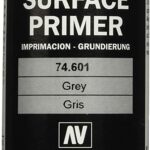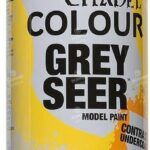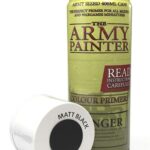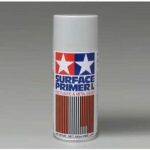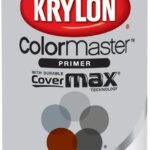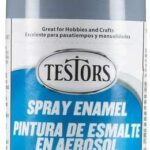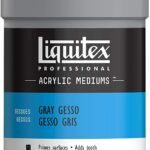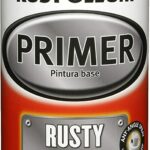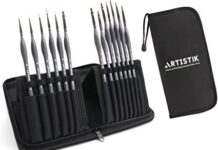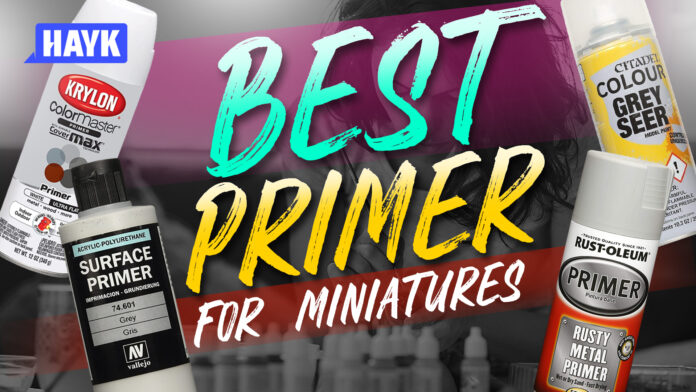
Picking the right primer can make or break your painting experience on your miniatures. With so many options to choose from, it can be hard to choose which is the best primer for miniatures.
Primers need to be picked according to the surface material of your miniature as there are other primers that work best only on specific surfaces like plastic or metals.
In general, primers are used as a preparatory coat over an unpainted surface like plastic or metal. But in the case of miniature primers, brush-on or spray primers that make smooth surfaces are the preferred primers to make painting smooth when held by your miniature holder.
In this article, we will cover the best primer for miniatures and models and talk about the most important factors that matter when shopping for a primer.
Contents of this Page
Why Should You Use Primers for Miniatures?
There are two primary reasons why primers are crucial when painting miniatures or models.
The first reason why miniature primers are used is that it gives an undertone on the miniature before you apply the actual colors. The second reason is that the primer bonds on the surface of your miniature and avoid compromising the color quality of your second coating.
But apart from those two, there are other reasons why primers are used on miniatures or models, which we’ll cover briefly in this article.
Primers for Miniature Helps Acrylic Paint to Stick to the Surface
Acrylic paints do not stick well to metals, plastic, or resin very well. However, primers do adhere to these surfaces really well and also provide a layer for your colored paint to cling to. Without primers, you will see the paint flaking off sooner or later.
Depending on the number of layers of primer you put will be how the surface will look like. For example, if you put too much primer on the miniatures, you will have an extremely smooth, plastic-like surface. Unfortunately, too much primer could cause the paint to not stick properly.
On the other hand, less primer on the miniature will give you better-defined detail that will promote your colored painting’s details.
When it comes to choosing the right primer for you, you should base it off according to the colors you will be using. If you are going to use darker colors, then know that you will need a darker primer to get the right darkness. On the other hand, if you are going to use light colors, then a light primer will fit best.
Essentially, you can choose primers that range from black to gray to white, depending on your needs. Among the shades of primers, gray is the most commonly used while the white primer is great for vibrant colors.
Bottom line is that it’s important to pair your primer’s color with the colors you will be working on because choosing dark primers will give you results that will look a bit dull on your miniatures or models.
Primers for Miniatures Help Prevent Scratches and Minor Flaws
Another primary use of primers is how it creates an even surface in preparation for the second coating colors you will be adding. The smooth surface is achieved because the primer fills in minor cracks and scratches on the miniature or models.
When you are working on miniature vehicles and aircraft, a smooth surface is very important as an uneven surface could damage the overall output. By using the right primer, you will achieve a really smooth surface that will make vehicles look even better.
Apart from vehicles, most miniatures have fine details and corner surfaces that require a detailed application. Using the right primer will coat these delicate areas perfectly so you can apply the details as accurately as they can be.
Primer for Miniatures Offer a Color Base
Primers have their own color, which makes it all the more crucial to choose accordingly. Depending on the color of the primer and the color you will be applying on the primer will be how well the item will turn out.
Even though primers come in a variety of colors, the most popular colors range from white, gray, and black. However, it doesn’t necessarily mean that you have to go with either white, gray, or black, as well, since it depends on the person’s painting process.
For example, some people use white more often while others avoid using it at all. Other people also often use gray rather than either white or black because it is the middle color to use. Ultimately, it boils down to how you want your final color to look like.
Primer offers More Precise Detail
The number of primers you add to your miniature models also matters. Depending on how much primer you add will make or break your painting details.
You see, if you add too much primer, it tends to cover up the details of fine lines and round edges of the miniatures. That is why knowing how much primer you add is very important if you don’t want to ruin the details later on.
However, not everyone knows how much primer to add. So, how do you know when enough is enough?
To know when you have added enough primer, your miniature should have a shiny surface once your miniature item has been cleaned. If you are going to use spray primers, make sure you apply this in a well-ventilated room or outside where there is plenty of natural light.
In most cases, the primer should provide a matte look– not glossy. When using miniature paints, place the miniature about a foot away from you and use short bursts of sprays, and apply it evenly on all sides of the miniature or model.
Once you have applied enough on all sides of the miniature, allow it to dry and it should have a completely matte look.
Best Primer for Miniatures and Models
1. VALLEJO Surface Primer
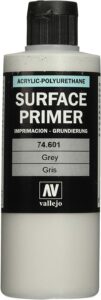
If you are looking for the best you can get regardless of your budget, then the VALLEJO Surface Primer is the best you can get your hands on. The colors and overall output you will get are perfect for modeling jobs and for miniature projects.
Note that VALLEJO’s Surface Primer comes in a variety of colors. However, if you are not sure which color to get, going grey is the safest option as it is the most versatile color that normally goes well with other colors.
Regardless if you are looking for a primer you can use for manual brushing or airbrushing, the VALLEJO Surface Primer will be the perfect primer. On top of that, the primer is also quick-drying, which means you can get your project rolling without any compromise in terms of both speed and quality.
It has to be noted as well that the primer needs to be thinned with water if you are thinking about using this with an airbrush. On top of that, it may require multiple coats to get a really smooth surface ideal for your final coating.
Using the VALLEJO Surface Primer for 3D printed pieces also works wonders as it allows you to apply thicker coats– perfect for hiding print lines from 3D printing. Nevertheless, the primer still performs outstandingly compared to most of its competitors in the market. Considering how affordable it is, they are ideal for working with pewter or plastic miniatures.
2. Citadel Paint Contrast Spray
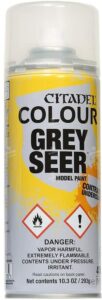
Even though the Citadel Paint Contrast Spray is a lot more expensive than our first primer, it still is preferred by plenty of painters and hobbyists. The Citadel Paint Contrast Spray is a great primer to use as a base coating for metal, plastic, and resin miniatures.
Furthermore, Citadel’s Paint Contrast Spray is also an excellent choice for those who are looking for a matte uniform base over your miniatures or models.
The Citadel Paint Contrast Spray can also be used to spray paint your miniature models. You can also rely on the paint to work easily when used for spray painting as it produces thin sprays. If you are worried that this might build up in more detailed parts of your miniature model, you can rest assured that it will not.
It has to be noted that the primer is specifically formulated and designed for miniatures and models, so you know that the primer will give you quality output. After you spray the primer on your model, you will be left with a smooth surface for covering it over with paint.
Overall, the Citadel Paint Contrast Spray is a versatile primer that is easy to apply. It also works on basically any surface, so you can count on the primer to adhere to your miniature models regardless of which material it is made out of.
It has to be noted as well that the primer is an aerosol primer, so make sure you use this in a well-ventilated place.
3. Army Painter Primer
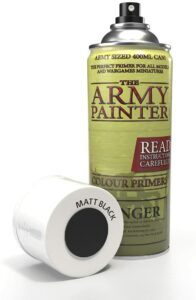
The Army Painter Primer is a good alternative to the Citadel Primer we just covered above. If you don’t know yet, Army Painter is a modeling company that has manufactured a variety of products for miniature hobbyists.
In the case of the Army Painter Primer, you can definitely rely on its performance since it is specifically formulated to work on all types of miniatures. Moreover, the Army Painter Primer is also made to work on various surfaces like plastic and metal.
Similar to the case of the Citadel Primer, this is a spray can, which should help make your painting job a lot faster. And similar to most spray cans, you need to be in a well-ventilated place for safety purposes.
Note that you need to use the spray in quick bursts from a decent distance away from the miniature (around 6 inches to 12 inches) to avoid applying too much primer on your model. Spraying in quick bursts is highly recommended to avoid messing up with detailed parts of your miniatures.
The Army Painter Primer also comes in a variety of colors, so if you need a specific color base, you can choose from plenty of color options. But of all the colors, the black primer has the best reviews. Note that the white primer may have a rep of causing problems with the quality of the final surface but most of these were due to environmental conditions.
In general, it is highly advised to use rattle can primers in lower humidity and normal room temperatures to get the best results.
4. Tamiya Surface Primer Spray
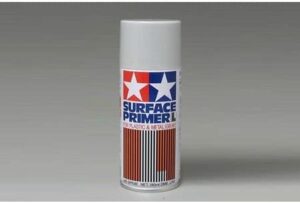
Regardless if you are a beginner or an experienced miniature painter, the Tamiya Surface Primer Spray will give you a top-quality surface. Apart from the high-quality finish of the primer, it is also fairly affordable.
Note that the Tamiya Surface Primer Spray has a neutral gray color, which should work perfectly for most miniature models. Unfortunately, you will have to look at the rest of our products in this list if you are looking for something that is either darker or lighter in shade.
Keep in mind that the Tamiya Surface Primer Spray is a spray can, which means it comes with its own positives and negatives, but it mainly has something to do with the quality of the coat. More specifically, the Tamiya Surface Primer Spray has a really good finish on models, giving you a really good quality coating.
On the other hand, the Tamiya Surface Primer Spray only works on speedy paintings and loses a lot of the “hands-on” feeling you get from drop primers. So, unless accuracy isn’t really something you need to worry about, then the Tamiya Surface Primer Spray should give you quality output.
Apart from miniatures, the primer can also be used for anything larger than miniature models. If you are looking to work on larger models or you need something that can cover large areas efficiently, then the Tamiya Surface Primer Spray is a solid choice.
Keep in mind though that unlike other primers on our list, the Tamiya Surface Primer Spray will not do thick coatings really well, but excels in making sure detailed parts or areas of your miniature model are kept as detailed as possible.
5. Krylon K05131507 ColorMaster Paint + Primer

The Krylon K05150107 ColorMaster Paint is a 12 oz spray can that is perfect for those of you who are looking for a primer with a larger volume. Apart from the great quality coating, the K05150107 also has a large volume for you to use on many models.
If you are looking for a primer that can be used for large projects, the K05150107 is the perfect option you should consider. Because of its large volume, the can is great for projects that go way beyond miniature models.
Because of the quality coating it provides you with, you can ensure that they are worth getting, and is perfect for projects that require more volume apart from high-quality coating output. Because it comes in a variety of colors and types, you can choose whichever is according to your needs and ensure that it will not mess with the details of the miniature models.
Another thing you need to know about the K05150107 is the fact that they work for various instances and uses, so regardless if you are new to miniature painting or an experienced one, your painting experience should end up with high-quality results.
Because the K05150107 doesn’t do thick coatings well, they are highly recommended for miniature projects that have very fine details.
The K05150107 comes in basic greys and whites for those who are looking for a basic coating for their models. Note that the Krylon K05150107 ColorMaster Paint also comes with a paint/primer combo, so make sure to look into that if you are looking for a perfectly compatible combo.
Overall, the Krylon K05150107 ColorMaster Paint is a solid pick if you want something that is easy to apply and is perfect for both beginners and experienced miniature painters.
6. Testors Enamel Primer
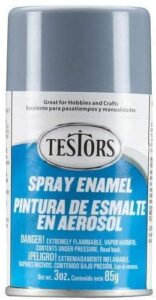
The Testors Enamel Primer is a direct competitor of the Tamiya Surface Primer Spray. Apart from having a very similar price, both are also enamel-based formulated specifically to work for undercoating. Moreover, it also is perfect for high-detailed miniatures and scale models as it doesn’t provide a thick coating when applied.
Similar to the Tamiya Surface Primer Spray, the Testors Enamel Primer provides a top-quality surface output. Since it is also a spray can, it also has its own ups and downs.
Regardless, the quality of the coat is something you will definitely be proud of afterwards. It has a really good finish on models but lacks the “hands-on” feeling. But because it gets the job done fast, you can count on the primer to finish more miniature products within a specific amount of time.
If accuracy isn’t something you are after, then the Testors Enamel Primer is another option that will definitely be worth investing in. Unfortunately, the Testors Enamel Primer doesn’t smell good as it literally stinks.
Because of the smell, it is highly advised that you work in a well-ventilated area to ensure that the smell won’t stay in one area or stick on surfaces.
Apart from the smell, the Testors Enamel Primer is also smaller compared to the Tamiya Surface Primer Spray. If you are looking to use this for larger projects, you might need a handful of these to cover all the miniature models you will be working on.
Even though it’s small, the output of the sprays is still top-notch and it should still give you detailed areas of your miniature models for the final coating. Thanks to the quality of the Testors Enamel Primer that it doesn’t do thick coatings well unlike other primers on our list.
7. Liquitex Neutral Gray Gesso
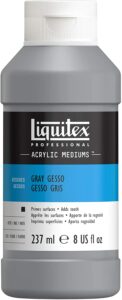
A well-known affordable primer on our list is the Liquitex Neutral Gray Gesso. It is the perfect budget-option for beginners and experienced painters alike.
Unlike most primers featured in this article, the Gesso Liquitex Neutral Gray is a fairly hard compound that is specifically formulated with plaster or a glue-like substance. Traditionally, the Liquitex Neutral Gray Gesso is used as an undercoat before painting because of how well it forms a solid foundation.
More specifically, the Liquitex seals off porous surfaces really well, making them perfectly useful for various surfaces like metal, plastic, or resin. Apart from grey, Liquitex also is available in other colors.
Keep in mind that even though liquitex Neutral Grey Gesso is fairly inexpensive it does coat surface area so well and provides a strong durable surface, which makes them perfect for just about any type of projects.
The overall viscosity of the Liquitex Neutral Gray Gesso is very flexible and it is also distinguishable as a thin primer, allowing you to preserve fine painting details on miniature models. However, when using brush in layers, it is still highly advised to be really careful when brush painting miniatures, especially when it comes to preserving details on a miniature model.
Another thing that you should also know about the Liquitex Neutral Gray Gesso is how it takes so long to completely dry the primer. In most cases, the models will take up to 24 hours to completely dry before you can apply another set of colored layers on the miniature model.
To get better, smoother layers, it is advised to sand in between multiple layers. Considering the fact that it takes too long to dry, sanding between layers is only advised if you are not in a hurry with your project.
8. Rust-Oleum Automotive Primer Spray

Don’t let the Rust-Oleum Automotive Primer fool you. Even though it has the word “Automotive” in its name doesn’t mean that it’s primarily intended for automotive models only, no. The primer can still be used on miniature models but they aren’t exactly ideal for very small models.
If you are someone who works on MFD or plastic terrain pieces, then the Rust-Oleum Automotive Primer is the perfect primer for you.
Among the main advantages of using this primer over the rest of the primers on our list is the fact that it is strong and cures into a very durable surface which you can then paint confidently. The gap-filling component also works wonders in layering out imperfections on your miniatures, especially if your model is 3D printed as they are known to hold flaws from the prints.
Apart from that, the Rust-Oleum primer is also known to protect your miniatures from environmental exposure such as blocking out ambient moisture to keep rusts at bay. With this feature, you can ensure that water-based acrylic paint will stay where they should be.
Note that because this is still a spray can, painting in a well-ventilated room or places is still highly advised. To avoid overcoating the model, keep some distance away from the model. This also ensures you will not lose any details on your miniatures.
Things to Consider when Looking for the Best Primer for Miniature
Choosing the right primer doesn’t just revolve around picking the right texture or shade. You see, there are other factors that could make or break your purchase. In this section, we will cover the things you should worry about besides color or shade.
Brush or Spray
When shopping for primers for miniature models, the first thing you need to consider is to check whether or not you need rush or spray. Both these methods are done differently but focus more on control.
If you need to get your primers on your models fast, then spraying should get what you need fast. On the other hand, if you need to add primers accurately in specific parts of your model, then the brush method should give you more control. Unfortunately, this is time-consuming compared to sprayable primers.
Shade
Another thing you should also consider when looking for primers for miniatures and models is the color. Picking the right base color for your miniatures will help make the output look great.
Because the base color could greatly affect the outcome of the miniature, knowing which color to choose is crucial. For example, choosing a prink primer for a zombie army won’t turn out really great.
Size
The size of the miniature model is also something you need to consider when choosing a primer. Note that spraying or brushing makes a difference, depending on the thickness of the primer.
When working on a large number of armies or smaller miniature models, spray primers normally work best. Brush primers may be ideal for larger models but it still doesn’t mean miniature models don’t benefit from it.
Regardless, picking the primer should depend on the type of material or miniature model you are painting. Remember, metal miniatures will require primers that work best on metal materials as opposed to plastic or wood miniatures.
Toxicity
Mind the type of primer you will use on miniatures, especially if kids are likely to get in contact with the miniature model you will be painting. Even if kids are old enough not to put toys in their mouths, you still have to be careful.
Figures that are colorful enough can be too attractive to kids, and it’s better to stay safe than sorry. For this case, it is important to use primers and colors that are non-toxic.
How to Prime Miniatures: Beginners Guide
Conclusion
That concludes our list of the best primers for miniatures. At this point, you should have a good idea of which are considered best as well as an idea of how to pick the right one for you (if you’ve read our definitive buying guide section).
To sum up, here are our 8 best primer for miniature models:
- If you want nothing but the best, then the VALLEJO Surface Primer is the primer for you. It excels in both performance and affordability.
- A good alternative to our top pick is the Citadel Paint Contrast Spray. It’s versatile, easy to apply, works on most surfaces, but is a tad more expensive.
- The Army Painter Primer is a product made for miniature hobbyists. Do note that it requires to be used in well-ventilated rooms or areas just like the rest of the primers on our list.
- Tamiya Surface Primer Spray is a top-notch primer that is perfect for both beginner and experienced miniature painters.
- Are you looking for a large volume primer? Then the Krylon K05150107 ColorMaster Paint is the right primer for you.
- If you are looking for a smaller alternative to the Tamiya Surface Primer Spray, then the Testors Enamel Primer is for you.
- Get the LIQUITEX Neutral Gray Gesso if you are looking for a very affordable primer that doesn’t perform anywhere near as bad as most budget primers in the market.
- If you fany working on automobile miniature models, then there is nothing better than the Rust-Oleum Automotive Primer.
Which among the primers you think will work best for your project? Share it with us in the comments section now!

